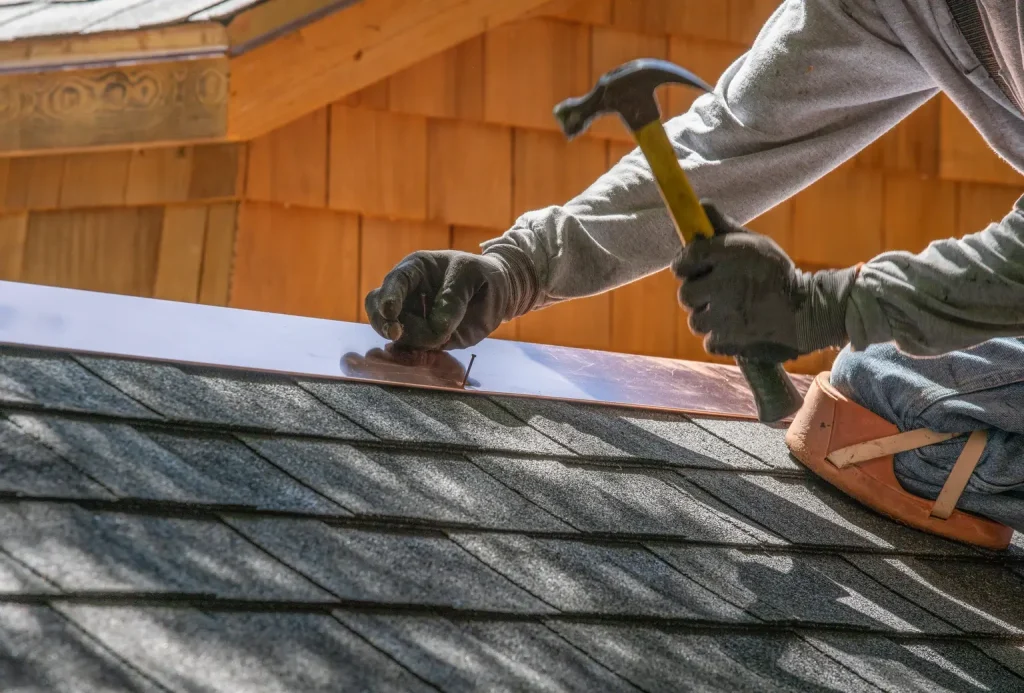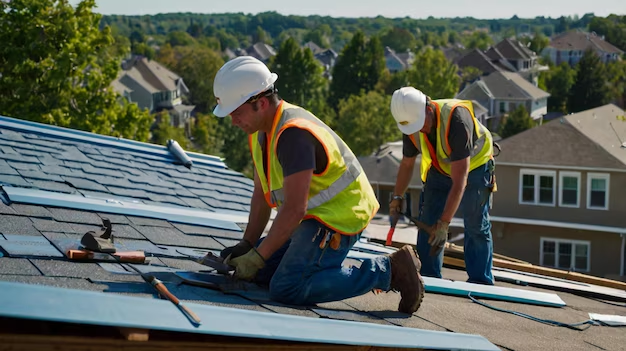To keep your roof in top shape, inspect it regularly for cracked or missing shingles, clean the gutters to prevent water buildup, trim overhanging branches, and make sure your attic is well-ventilated. Fix leaks or water stains as soon as they appear to prevent costly damage.
At FRS Roofing, we’ve repaired thousands of asphalt shingle roofs and know firsthand how neglecting small roof leaks can lead to severe roof damages, interior dry wall damage, and costly foundation issues. In this article, you’ll discover the 10 most critical signs your roof needs repair, plus professional roof maintenance tips and real examples to help you make the right decision for your property.
1. Water Stains on Ceilings or Walls
Water stains on your ceiling or walls are a clear indicator of roof leaks or hidden installation problems. You may notice brown discoloration forming near windows, the attic, or roof valleys where water tends to collect.
Example: One homeowner in Medford ignored small water rings on the ceiling. Within weeks, moisture spread into the insulation and caused mold and mildew growth drastically increasing the roof repair cost to nearly ten times more than what a simple patch would have been.
Maintenance Tip:
Inspect your attic with a flashlight. Look for cracking, rotting wood, and damp insulation. Address these issues quickly to prevent health problems related to mold and mildew.
2. Granule Loss and Debris Buildup in Gutters
Your gutters play a vital role in directing water away from your foundation. However, granule loss, debris buildup, and debris blockage can lead to overflow and roof leak formation.
Common causes include:
- Aging asphalt shingles shedding minerals
- Leaves, sticks, and limb trimmings collecting in the gutters
- Bird droppings and tree sap adding to sticky debris piles
When granules wash off, your shingles lose UV resistance, increasing the risk of cracking and curling.
Roof Maintenance Tip:
Clean your gutters by hand or with a proper tool twice per year. For safety, use a ladder secured on a flat surface and wear rubber boots for grip. If the buildup is heavy, call a professional roofing contractor like FRS Roofing for safe debris removal.
3. Sunlight or Wind Entering Through the Attic
If you see light filtering through the attic, it’s a warning that cracks, gaps, or damaged decking exist in your roof system. Wind damage and missing shingles often cause these openings.
Fact: Any visible sunlight means water and pests have a path inside your home.
Recommendation:
Check during daylight; if sunlight is visible, mark the areas. Cover small openings temporarily, but seek a professional roof inspection immediately. Leaving gaps open can lead to dry wall damage and interior rot.
4. The Age and Condition of Your Roof
Every roofing material has a predictable lifespan. The condition of your roof depends on maintenance inspections, installation quality, and exposure to wind, UV, and debris.
| Roof Type | Average Lifespan (Years) | Common Problems | Maintenance Frequency |
| Asphalt Shingle Roof | 15–25 | Granule loss, curling | Every 2 years |
| Metal Roof | 40–70 | Rust, loose fasteners | Every 5 years |
| Flat Roof | 20–30 | Ponding water, cracks | Every 2 years |
| Tile Roof | 30–50 | Broken tiles, debris blockage | Every 3–5 years |
Expert Note: Once your roof passes 15 years, schedule annual maintenance inspections. An aging roof may still perform well with timely repairs and maintenance of roof decking.
5. Persistent Roof Leaks
A roof leak can start small but quickly expand. Moisture seeps through roof penetrations like plumbing vent pipes, chimneys, and skylights, soaking insulation and damaging the interior.
Causes of Roof Leaks:
- Loose flashing around chimneys or vent pipes
- Cracked neoprene pipe boot sealing the plumbing vent
- Compromised roof valleys where two sections meet
Roof Maintenance Tip:
Use binoculars to inspect flashing edges and roof penetrations after a storm. Replace damaged boots or flashing immediately. If leaks persist, contacting FRS Roofing delaying can turn small roofing issues into major roof damages.
6. Damaged Flashing and Roof Penetrations
Flashing is a thin metal layer that seals joints and prevents water entry near chimneys, skylights, and roof vents. When flashing loosens, cracks, or corrodes, leaks form beneath the roofing materials.
Common Flashing Issues:
- Improper installation or missing sealant
- Separation from roof decking due to weight or wind damage
- Faulty neoprene pipe boots around plumbing pipes
Did You Know? Around 80% of roof leaks occur around roof penetrations. Preventive maintenance inspections help identify these weak points early.
Recommendation:
FRS Roofing suggests using high-quality flashing materials such as aluminum or copper. Always have flashing repairs handled by experienced roofing professionals to avoid further harm or installation problems.
7. Sagging Roof Decking or Structural Rot
If your roof decking begins to sag, it often means rot or trapped moisture has weakened the wood structure. This compromises the entire roof system and creates a potential safety hazard.
Signs to Look For:
- A visible dip at the top or bottom of the roofline
- Soft spots when walking on shingles
- Bubbling or discoloration on the ceiling
Roof Maintenance Tip:
Avoid stepping on sagging sections. Contact FRS Roofing for an evaluation of your decking condition. In some cases, damaged beams require full roof replacement to restore structural resistance and stability.
8. Missing, Cracked, or Curling Shingles
When shingles begin cracking or curling at the edges, the roofing material is losing flexibility. This can result from UV exposure, age, or poor roof installation.
Shingle Roof Maintenance Guide:
- Replace broken shingles promptly.
- Secure edges using roofing adhesive.
- Inspect the course alignment to ensure proper overlap.
Pro Roofing Tip:
Inspect your asphalt shingles after every strong wind event. Lifted shingles can expose the underlayment, letting water seep beneath and cause hidden damage to the roof decking.
9. Growth of Moss, Algae, and Mold
Moss growth, algae, and mold aren’t just aesthetic issues; they retain water on your roof’s surface and lead to premature rotting of wood and shingles. They thrive in shaded areas with poor drainage.
Maintenance Tip:
- Trim nearby tree limbs to increase sunlight exposure.
- Apply zinc or copper strips to discourage moss growth.
- Avoid power washing, which can strip protective minerals.
Important: Ignoring organic buildup may cause health problems, especially for those sensitive to spores. Regular cleaning helps protect your roof investment and home.
10. Poor Ventilation and Soffit or Vent Problems
A well-ventilated attic keeps your roofing materials dry and temperature-stable. Blocked soffit vents or roof vents can trap humidity, leading to mold, rot, and decking damage.
Things to Inspect:
- Clogged vent pipes or debris blocking airflow
- Damaged soffit panels or insulation buildup
- Signs of condensation or mildew near plumbing pipes
Maintenance of Roof Ventilation:
Clear debris blockage from vent pipes and roof valleys. Install baffles for improved airflow. FRS Roofing recommends checking ventilation during seasonal roof maintenance and inspections.
Roof Repair Urgency Chart
| Sign | Severity | Urgency | Average Repair Cost |
| Minor leaks / stains | Moderate | Within 1 week | $250 – $750 |
| Cracked shingles | High | 2–3 days | $300 – $1,000 |
| Sagging decking | Critical | Immediate | $2,000 – $5,000+ |
| Flashing damage | High | 1 week | $500 – $1,200 |
| Moss or mold growth | Moderate | Within 1 month | $400 – $900 |
Professional Maintenance Tips from FRS Roofing

Here are proven roofing tips for homeowners and maintenance of roof practices to keep your roof system performing optimally:
- Schedule Regular Maintenance Inspections:
Catch small issues early before they become roof damages. - Clean Roof and Gutters:
Remove leaves, sticks, and debris piles regularly to avoid debris blockage. - Trim Tree Limbs:
Overhanging tree limbs can scratch shingles, cause wind damage, and deposit bird droppings. - Check Flashing and Pipe Boots:
Inspect neoprene pipe boots, chimneys, and skylights for cracks or deterioration. - Maintain Proper Drainage:
Ensure roof valleys and gutters stay clear for effective water flow. - Review Warranties and Insurance Claims:
Keep copies of your roof warranty and confirm your insurance claim coverage before major repairs. - Avoid DIY on Complex Repairs:
Without the right tools, knowledge, and experience, you may worsen the damage.
Learning from Industry Experience
Even professionals like Bill Ragan Roofing emphasize the importance of regular maintenance. Whether you have an asphalt shingle roof or flat system, consistent upkeep protects your roof investment and ensures your warranty remains valid.
Insight: According to experts in the roofing industry, neglecting regular maintenance inspections shortens a roof’s lifespan by up to 30%.
When to Call a Professional Roofing Contractor
If you spot any of the signs mentioned roof leaks, moss growth, flashing cracks, or curling shingles it’s time to call a trusted roofing contractor.
FRS Roofing provides:
- Roof repairs and full roof replacements
- Maintenance inspections and cleaning
- Gutter, chimney, and skylight servicing
- Assistance with insurance claims and warranties
FRS Roofing Your Local Experts in Roof Care, Safety, and Long-Term Protection.
FAQs – Roof Repair & Maintenance
Q1: How often should I inspect my roof?
A: You should inspect your roof at least twice a year—once in spring and once in fall.
Q2: What are the most common signs of roof damage?
A: Water stains, missing shingles, sagging sections, and mold growth are common signs.
Q3: Can I repair a roof leak myself?
A: Minor leaks can be patched, but professional inspection ensures long-term safety.
Q4: How long does an asphalt shingle roof last?
A: An asphalt shingle roof typically lasts between 20 to 30 years with proper maintenance.
Q5: Does homeowners insurance cover roof repairs?
A: Yes, if the damage is caused by sudden events like storms or wind, not regular wear.
Q6: What causes roof leaks most often?
A: Cracked flashing, damaged shingles, or clogged gutters are the main culprits.
Q7: How can I prevent moss or mold growth on my roof?
A: Keep the roof clean, remove debris, and ensure proper drainage and sunlight exposure.
Q8: When should I replace my roof instead of repairing it?
A: Replace it if repairs are frequent or the roof is nearing the end of its lifespan.
Q9: What’s the best roofing material for long-term durability?
A: Metal roofing and high-quality asphalt shingles offer excellent durability and resistance.
Q10: Is it safe to walk on my roof during inspection?
A: It’s best to avoid it, use binoculars or hire a professional roofer for safety.
Conclusion
Every homeowner takes pride in maintaining their home, but the roof often goes unnoticed until problems arise. Knowing these 10 warning signs gives you the knowledge to act early, saving money, preserving your roof investment, and avoiding structural damage.
By following expert roof maintenance tips and trusting FRS Roofing a leading professional in the roofing industry you can extend your roof’s life, protect your interior, and ensure your home remains safe for years to come.

